A southern New South Wales trial exploring the impacts of deep placement of organic and inorganic amendments on alkaline-sodic subsoils has shown significant grain yield increases over two consecutive years.
The trial was established with GRDC and NSW Department of Primary Industries co-investment on alkaline-sodic soils at Rodney and Sue Trethowan's farm near Rand, NSW.
Research work was initiated at the farm in late February 2017 to examine the changes in soil properties and grain yields following surface and subsurface application of organic and inorganic amendments.
Sodic soils have a high proportion of sodium on their cation exchange complex and are prone to dispersion and poor water infiltration. As a consequence, these soils often suffer from transient waterlogging, run-off and gully erosion. They are also susceptible to surface crusting and hard setting, which can hinder seedling emergence and root penetration.
Crops grown on sodic soils frequently suffer from poor root growth because of high soil strength and extreme alkalinity, especially in the subsoil, and limited availability of water and nutrients. These physical and chemical soil properties reduce crop growth and grain yield.
To understand how subsoil application of amendments affects these constraints, GRDC has invested in a five-year multi-agency team of researchers from Victoria, Tasmania, South Australia and southern NSW, led by Agriculture Victoria's Dr Roger Armstrong.

NSW Department of Primary Industries researchers at trial set up, with the custom-built deep ripping, manuring and fertilising machine. Photo: Nicole Baxter
NSW DPI soil scientist Dr Ehsan Tavakkoli, who leads the southern NSW node of the research, says positive improvements in crop productivity have been achieved by ameliorating sodic soils at Rand, 100 kilometres south-east of Wagga Wagga.
Trial details
The trial was established in a paddock that had been cropped for many years under a cereal/canola rotation.
Dr Tavakkoli says subsoil pH (1:5 water) ranged from 5.1 to 9.1 with increasing sodicity at depth (exchangeable sodium measuring up to 30 per cent).
"With a bulk density of 1.55 grams per cubic centimetre, water movement through the subsoil was restricted and unfavourable for root growth," Dr Tavakkoli says.
"Despite the limited water movement, we found a considerable amount of soil water remaining below 60cm after harvest which suggests severe limitations to root growth and reduced crop access to subsoil water."
In 2017, Dr Tavakkoli and his team established 14 treatments with four replicates comprising:
- an untreated control;
- surface application of gypsum;
- surface application of chicken manure;
- surface application of pea hay;
- deep ripping (no ameliorants);
- deep placement of gypsum;
- deep placement of manure;
- deep placement of wheat stubble;
- deep placement of wheat stubble and nutrients;
- deep placement of pea hay, deep placement of biochar;
- deep placement of pea hay and nutrients;
- deep placement of liquid nutrients; and
- deep placement of pea hay and gypsum and nutrients.
A custom-built deep banding and ripping machine developed by NSW DPI with tynes set on 500-millimetre row spacings was used to place inorganic and organic amendments and liquid nutrients into the subsoil.
The researchers sowed La Trobe (PBR) barley during 2017 and LongReach Lancer (PBR) wheat in 2018 with 80 kilograms per hectare of mono-ammonium phosphate (18kg/ha of phosphorus and 8kg/ha of nitrogen).
Growing season rainfall in 2017 and 2018 was 329mm and 225mm, respectively.

Canola root growth has improved. Photo: Dr Ehsan Tavakkoli
In 2017, rainfall during the April to November growing season was 62.5mm less than the long-term average, and, in 2018, 178mm less than the long-term average.
Yield response
In the amended plots, plants were monitored over the rip lines and between the rip lines, and were also compared to the untreated control plots.
Dr Tavakkoli says the deep placement of amendments into the alkaline-sodic subsoil during late February 2017 had a significant impact on grain yields in 2017 and 2018.
"Compared with the control in 2017, the greatest increase in barley yields was observed in the deep-placed pea hay, gypsum and nutrient treatment at 27 per cent, followed by deep-placed manure at 22 per cent, and deep-placed pea hay at 20 per cent," he says.
"In 2018, a 53 per cent increase in wheat yield was observed in the deep-placed pea hay, gypsum and nutrient treatment, followed by deep-placed gypsum at 34 per cent, deep-placed pea hay at 34 per cent and deep-placed wheat stubble/nutrients at 27 per cent."
Soil changes
Dr Tavakkoli undertook soil tests during May 2018, 14 months after the experiment started.
He says the main changes recorded were a reduction in subsoil pH and exchangeable sodium percentage, increased soil porosity and improved crop water use around the rip line containing the organic and/or inorganic amendments.
"The extent of the changes in the soil chemical and physical properties in the 15 to 40cm layers of this alkaline-sodic subsoil following deep incorporation of organic and/or inorganic amendments was remarkable," he says.
"The results clearly demonstrated that amelioration of multiple soil constraints such as high pH, sodicity and poorly structured aggregates, requires amendments with various modes of action and independent mechanisms."
Dr Tavakkoli says the improvement in subsoil aggregation with organic matter plus gypsum and the resulting significant increases in grain yield can be attributed to two factors.
"The first was the application of gypsum that reduced pH between 0.86 and 1.15 units in this highly alkaline subsoil," he says.
"The second is that the organic amendments provided an environment that greatly enhanced microbial activity in and around the rip lines."
Research at the site will continue to monitor grain yields and soil changes for another three years.
An economic analysis will also be undertaken to determine the cost-effectiveness of subsoil amelioration.
More information: Dr Ehsan Tavakkoli, 02 6938 1992, ehsan.tavakkoli@dpi.nsw.gov.au

























































